belt JEEP WRANGLER UNLIMITED 2021 Owner handbook (in English)
[x] Cancel search | Manufacturer: JEEP, Model Year: 2021, Model line: WRANGLER UNLIMITED, Model: JEEP WRANGLER UNLIMITED 2021Pages: 330, PDF Size: 9.16 MB
Page 120 of 330
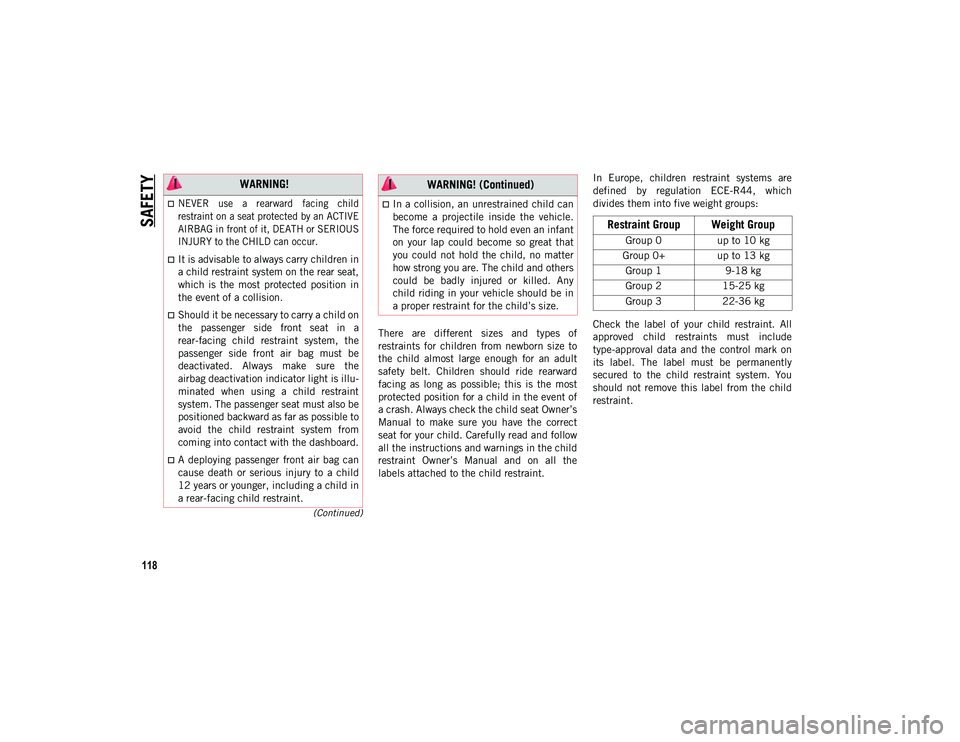
SAFETY
118
(Continued)
There are different sizes and types of
restraints for children from newborn size to
the child almost large enough for an adult
safety belt. Children should ride rearward
facing as long as possible; this is the most
protected position for a child in the event of
a crash. Always check the child seat Owner’s
Manual to make sure you have the correct
seat for your child. Carefully read and follow
all the instructions and warnings in the child
restraint Owner’s Manual and on all the
labels attached to the child restraint.In Europe, children restraint systems are
defined by regulation ECE-R44, which
divides them into five weight groups:
Check the label of your child restraint. All
approved child restraints must include
type-approval data and the control mark on
its label. The label must be permanently
secured to the child restraint system. You
should not remove this label from the child
restraint.
WARNING!
NEVER use a rearward facing child
restraint on a seat protected by an ACTIVE
AIRBAG in front of it, DEATH or SERIOUS
INJURY to the CHILD can occur.
It is advisable to always carry children in
a child restraint system on the rear seat,
which is the most protected position in
the event of a collision.
Should it be necessary to carry a child on
the passenger side front seat in a
rear-facing child restraint system, the
passenger side front air bag must be
deactivated. Always make sure the
airbag deactivation indicator light is illu
-
minated when using a child restraint
system. The passenger seat must also be
positioned backward as far as possible to
avoid the child restraint system from
coming into contact with the dashboard.
A deploying passenger front air bag can
cause death or serious injury to a child
12 years or younger, including a child in
a rear-facing child restraint.
In a collision, an unrestrained child can
become a projectile inside the vehicle.
The force required to hold even an infant
on your lap could become so great that
you could not hold the child, no matter
how strong you are. The child and others
could be badly injured or killed. Any
child riding in your vehicle should be in
a proper restraint for the child’s size.
WARNING! (Continued)
Restraint Group Weight Group
Group 0 up to 10 kg
Group 0+ up to 13 kg
Group 1 9-18 kg
Group 2 15-25 kg
Group 3 22-36 kg
2020_JEEP_JL_WRANGLER_UG_RHD_UK.book Page 118
Page 121 of 330
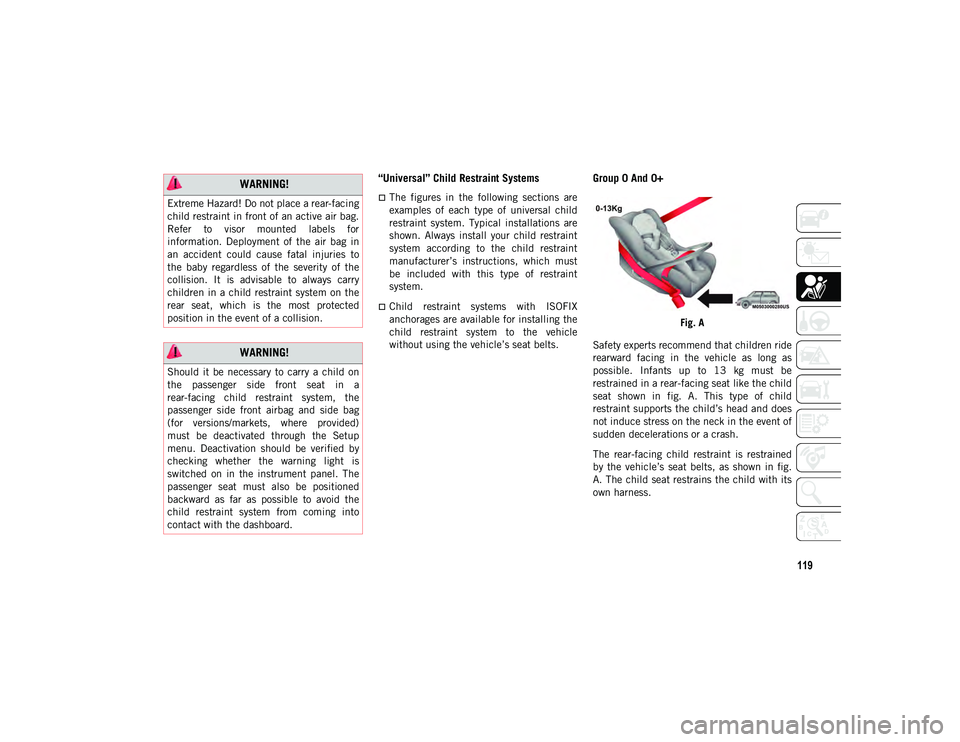
119
“Universal” Child Restraint Systems
The figures in the following sections are
examples of each type of universal child
restraint system. Typical installations are
shown. Always install your child restraint
system according to the child restraint
manufacturer’s instructions, which must
be included with this type of restraint
system.
Child restraint systems with ISOFIX
anchorages are available for installing the
child restraint system to the vehicle
without using the vehicle’s seat belts.
Group 0 And 0+
Fig. A
Safety experts recommend that children ride
rearward facing in the vehicle as long as
possible. Infants up to 13 kg must be
restrained in a rear-facing seat like the child
seat shown in fig. A. This type of child
restraint supports the child’s head and does
not induce stress on the neck in the event of
sudden decelerations or a crash.
The rear-facing child restraint is restrained
by the vehicle’s seat belts, as shown in fig.
A. The child seat restrains the child with its
own harness.
WARNING!
Extreme Hazard! Do not place a rear-facing
child restraint in front of an active air bag.
Refer to visor mounted labels for
information. Deployment of the air bag in
an accident could cause fatal injuries to
the baby regardless of the severity of the
collision. It is advisable to always carry
children in a child restraint system on the
rear seat, which is the most protected
position in the event of a collision.
WARNING!
Should it be necessary to carry a child on
the passenger side front seat in a
rear-facing child restraint system, the
passenger side front airbag and side bag
(for versions/markets, where provided)
must be deactivated through the Setup
menu. Deactivation should be verified by
checking whether the warning light is
switched on in the instrument panel. The
passenger seat must also be positioned
backward as far as possible to avoid the
child restraint system from coming into
contact with the dashboard.
2020_JEEP_JL_WRANGLER_UG_RHD_UK.book Page 119
Page 122 of 330
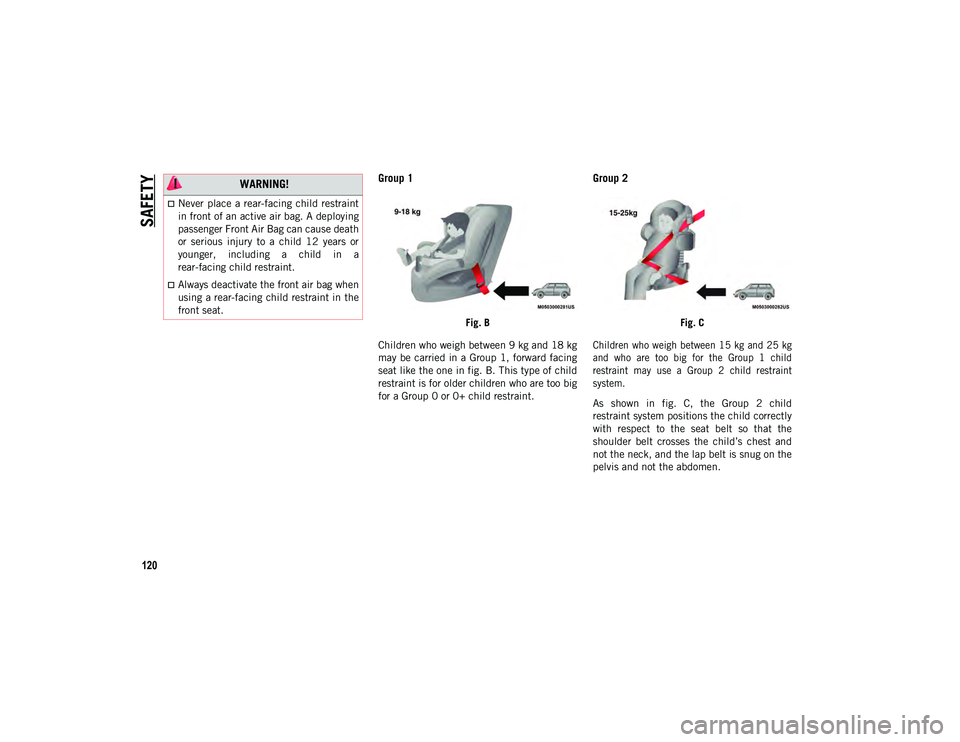
SAFETY
120
Group 1
Fig. B
Children who weigh between 9 kg and 18 kg
may be carried in a Group 1, forward facing
seat like the one in fig. B. This type of child
restraint is for older children who are too big
for a Group 0 or 0+ child restraint.
Group 2
Fig. C
Children who weigh between 15 kg and 25 kg
and who are too big for the Group 1 child
restraint may use a Group 2 child restraint
system.
As shown in fig. C, the Group 2 child
restraint system positions the child correctly
with respect to the seat belt so that the
shoulder belt crosses the child’s chest and
not the neck, and the lap belt is snug on the
pelvis and not the abdomen.
WARNING!
Never place a rear-facing child restraint
in front of an active air bag. A deploying
passenger Front Air Bag can cause death
or serious injury to a child 12 years or
younger, including a child in a
rear-facing child restraint.
Always deactivate the front air bag when
using a rear-facing child restraint in the
front seat.
2020_JEEP_JL_WRANGLER_UG_RHD_UK.book Page 120
Page 123 of 330
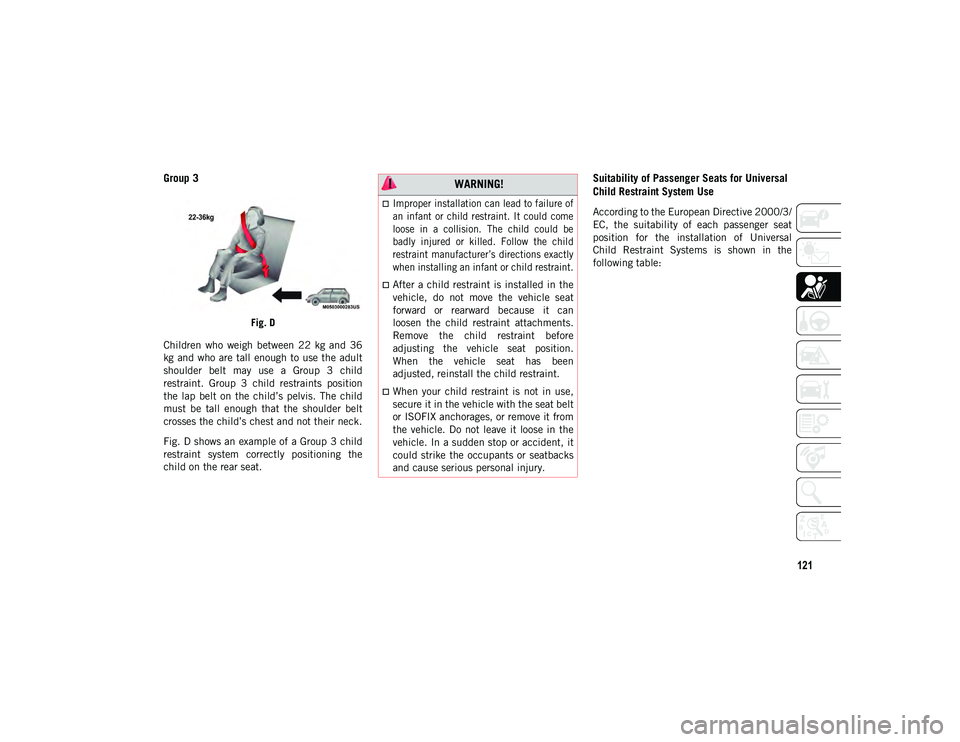
121
Group 3
Fig. D
Children who weigh between 22 kg and 36
kg and who are tall enough to use the adult
shoulder belt may use a Group 3 child
restraint. Group 3 child restraints position
the lap belt on the child’s pelvis. The child
must be tall enough that the shoulder belt
crosses the child’s chest and not their neck.
Fig. D shows an example of a Group 3 child
restraint system correctly positioning the
child on the rear seat.
Suitability of Passenger Seats for Universal
Child Restraint System Use
According to the European Directive 2000/3/
EC, the suitability of each passenger seat
position for the installation of Universal
Child Restraint Systems is shown in the
following table:
WARNING!
Improper installation can lead to failure of
an infant or child restraint. It could come
loose in a collision. The child could be
badly injured or killed. Follow the child
restraint manufacturer’s directions exactly
when installing an infant or child restraint.
After a child restraint is installed in the
vehicle, do not move the vehicle seat
forward or rearward because it can
loosen the child restraint attachments.
Remove the child restraint before
adjusting the vehicle seat position.
When the vehicle seat has been
adjusted, reinstall the child restraint.
When your child restraint is not in use,
secure it in the vehicle with the seat belt
or ISOFIX anchorages, or remove it from
the vehicle. Do not leave it loose in the
vehicle. In a sudden stop or accident, it
could strike the occupants or seatbacks
and cause serious personal injury.
2020_JEEP_JL_WRANGLER_UG_RHD_UK.book Page 121
Page 126 of 330
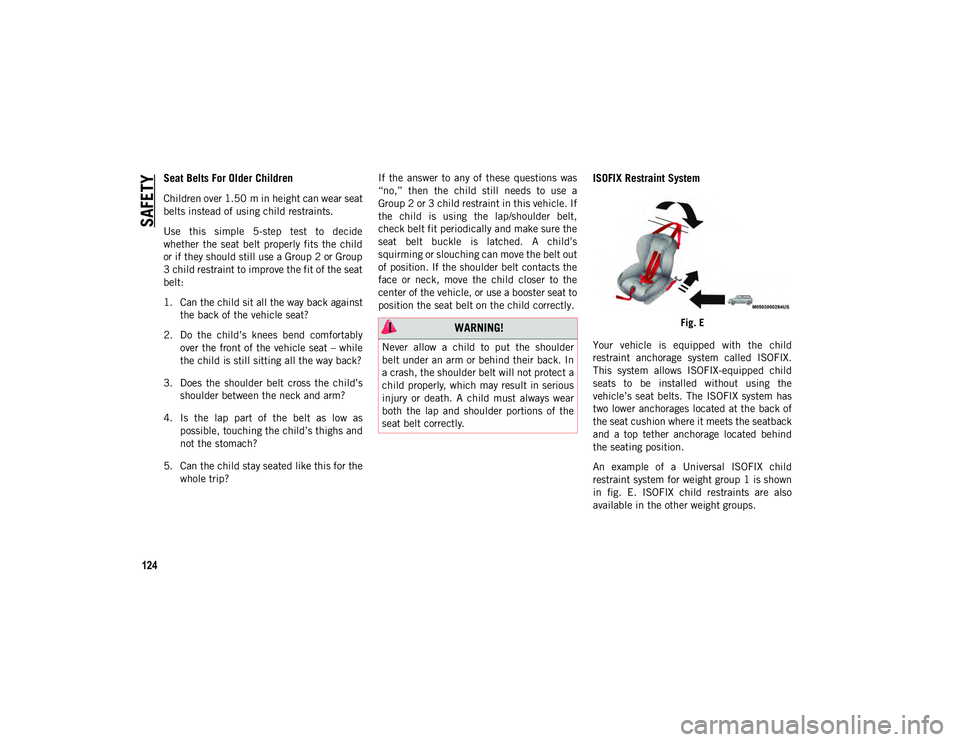
SAFETY
124
Seat Belts For Older Children
Children over 1.50 m in height can wear seat
belts instead of using child restraints.
Use this simple 5-step test to decide
whether the seat belt properly fits the child
or if they should still use a Group 2 or Group
3 child restraint to improve the fit of the seat
belt:
1. Can the child sit all the way back againstthe back of the vehicle seat?
2. Do the child’s knees bend comfortably over the front of the vehicle seat – while
the child is still sitting all the way back?
3. Does the shoulder belt cross the child’s shoulder between the neck and arm?
4. Is the lap part of the belt as low as possible, touching the child’s thighs and
not the stomach?
5. Can the child stay seated like this for the whole trip? If the answer to any of these questions was
“no,” then the child still needs to use a
Group 2 or 3 child restraint in this vehicle. If
the child is using the lap/shoulder belt,
check belt fit periodically and make sure the
seat belt buckle is latched. A child’s
squirming or slouching can move the belt out
of position. If the shoulder belt contacts the
face or neck, move the child closer to the
center of the vehicle, or use a booster seat to
position the seat belt on the child correctly.
ISOFIX Restraint System
Fig. E
Your vehicle is equipped with the child
restraint anchorage system called ISOFIX.
This system allows ISOFIX-equipped child
seats to be installed without using the
vehicle’s seat belts. The ISOFIX system has
two lower anchorages located at the back of
the seat cushion where it meets the seatback
and a top tether anchorage located behind
the seating position.
An example of a Universal ISOFIX child
restraint system for weight group 1 is shown
in fig. E. ISOFIX child restraints are also
available in the other weight groups. WARNING!
Never allow a child to put the shoulder
belt under an arm or behind their back. In
a crash, the shoulder belt will not protect a
child properly, which may result in serious
injury or death. A child must always wear
both the lap and shoulder portions of the
seat belt correctly.
2020_JEEP_JL_WRANGLER_UG_RHD_UK.book Page 124
Page 128 of 330
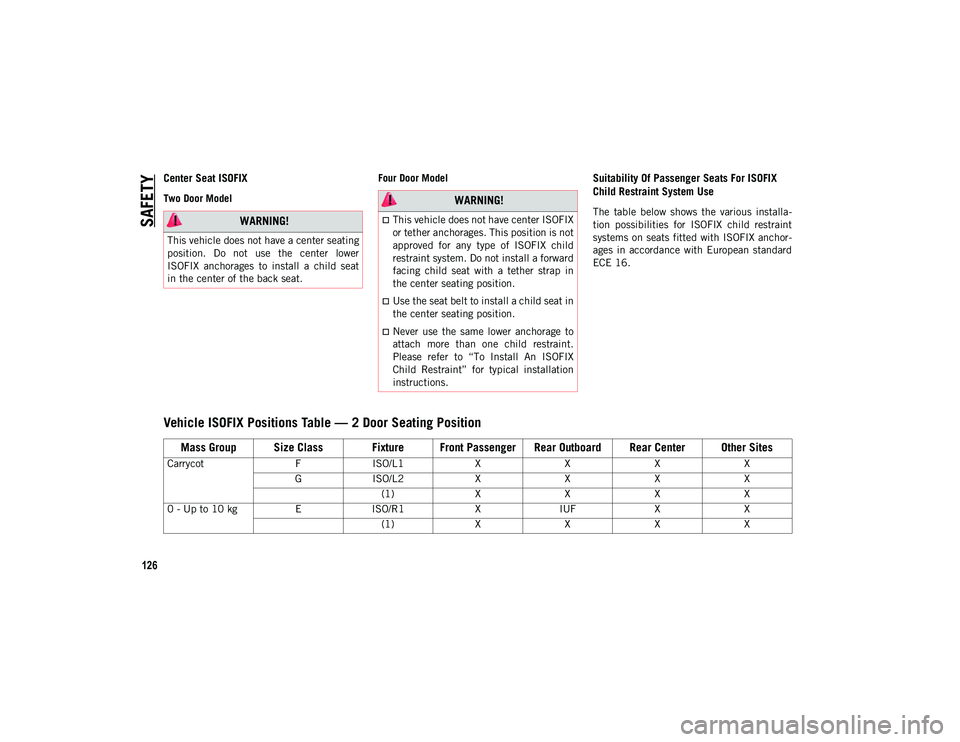
SAFETY
126
Center Seat ISOFIX
Two Door ModelFour Door Model
Suitability Of Passenger Seats For ISOFIX
Child Restraint System Use
The table below shows the various installa
-
tion possibilities for ISOFIX child restraint
systems on seats fitted with ISOFIX anchor -
ages in accordance with European standard
ECE 16. WARNING!
This vehicle does not have a center seating
position. Do not use the center lower
ISOFIX anchorages to install a child seat
in the center of the back seat.
WARNING!
This vehicle does not have center ISOFIX
or tether anchorages. This position is not
approved for any type of ISOFIX child
restraint system. Do not install a forward
facing child seat with a tether strap in
the center seating position.
Use the seat belt to install a child seat in
the center seating position.
Never use the same lower anchorage to
attach more than one child restraint.
Please refer to “To Install An ISOFIX
Child Restraint” for typical installation
instructions.
Vehicle ISOFIX Positions Table — 2 Door Seating Position
Mass Group Size Class Fixture Front Passenger Rear Outboard Rear Center Other Sites
Carrycot FISO/L1 XXXX
G ISO/L2 XXXX
(1) XXXX
0 - Up to 10 kg EISO/R1 XIUF XX
(1) XXXX
2020_JEEP_JL_WRANGLER_UG_RHD_UK.book Page 126
Page 131 of 330
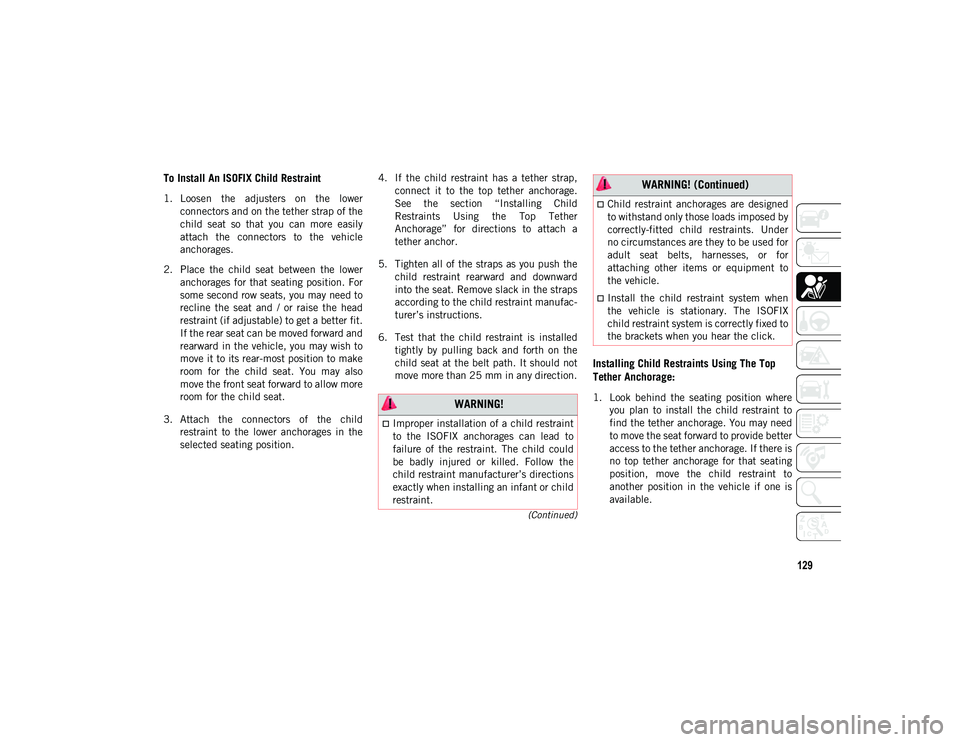
129
(Continued)
To Install An ISOFIX Child Restraint
1. Loosen the adjusters on the lowerconnectors and on the tether strap of the
child seat so that you can more easily
attach the connectors to the vehicle
anchorages.
2. Place the child seat between the lower anchorages for that seating position. For
some second row seats, you may need to
recline the seat and / or raise the head
restraint (if adjustable) to get a better fit.
If the rear seat can be moved forward and
rearward in the vehicle, you may wish to
move it to its rear-most position to make
room for the child seat. You may also
move the front seat forward to allow more
room for the child seat.
3. Attach the connectors of the child restraint to the lower anchorages in the
selected seating position. 4. If the child restraint has a tether strap,
connect it to the top tether anchorage.
See the section “Installing Child
Restraints Using the Top Tether
Anchorage” for directions to attach a
tether anchor.
5. Tighten all of the straps as you push the child restraint rearward and downward
into the seat. Remove slack in the straps
according to the child restraint manufac -
turer’s instructions.
6. Test that the child restraint is installed tightly by pulling back and forth on the
child seat at the belt path. It should not
move more than 25 mm in any direction.
Installing Child Restraints Using The Top
Tether Anchorage:
1. Look behind the seating position whereyou plan to install the child restraint to
find the tether anchorage. You may need
to move the seat forward to provide better
access to the tether anchorage. If there is
no top tether anchorage for that seating
position, move the child restraint to
another position in the vehicle if one is
available. WARNING!
Improper installation of a child restraint
to the ISOFIX anchorages can lead to
failure of the restraint. The child could
be badly injured or killed. Follow the
child restraint manufacturer’s directions
exactly when installing an infant or child
restraint.
Child restraint anchorages are designed
to withstand only those loads imposed by
correctly-fitted child restraints. Under
no circumstances are they to be used for
adult seat belts, harnesses, or for
attaching other items or equipment to
the vehicle.
Install the child restraint system when
the vehicle is stationary. The ISOFIX
child restraint system is correctly fixed to
the brackets when you hear the click.
WARNING! (Continued)
2020_JEEP_JL_WRANGLER_UG_RHD_UK.book Page 129
Page 132 of 330
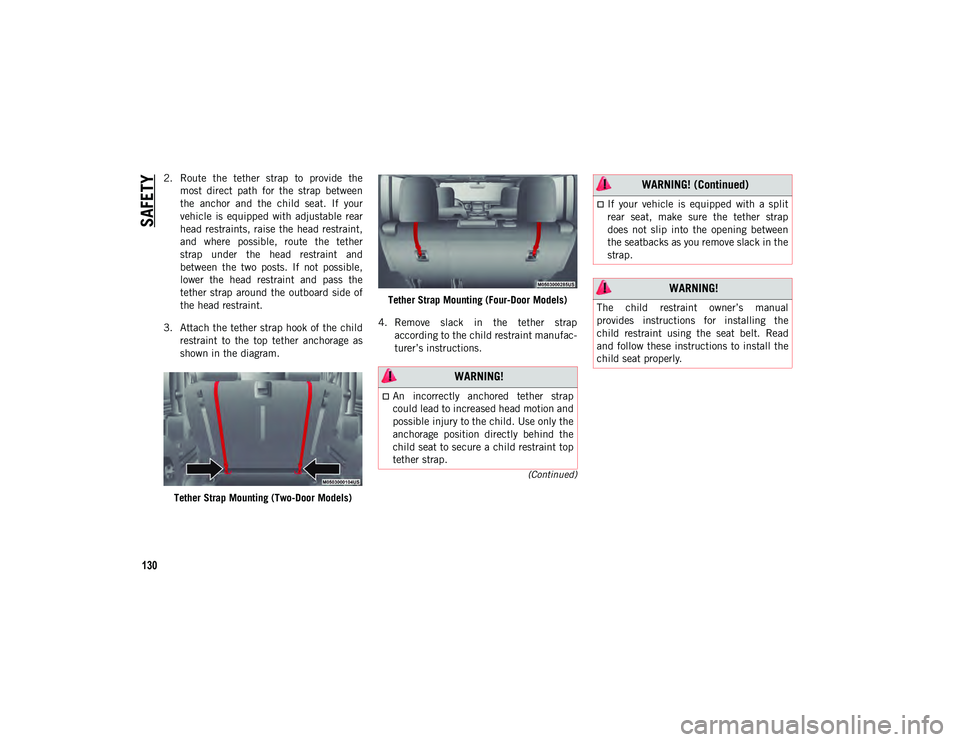
SAFETY
130
(Continued)
2. Route the tether strap to provide themost direct path for the strap between
the anchor and the child seat. If your
vehicle is equipped with adjustable rear
head restraints, raise the head restraint,
and where possible, route the tether
strap under the head restraint and
between the two posts. If not possible,
lower the head restraint and pass the
tether strap around the outboard side of
the head restraint.
3. Attach the tether strap hook of the child restraint to the top tether anchorage as
shown in the diagram.
Tether Strap Mounting (Two-Door Models) Tether Strap Mounting (Four-Door Models)
4. Remove slack in the tether strap according to the child restraint manufac -
turer’s instructions.
WARNING!
An incorrectly anchored tether strap
could lead to increased head motion and
possible injury to the child. Use only the
anchorage position directly behind the
child seat to secure a child restraint top
tether strap.
If your vehicle is equipped with a split
rear seat, make sure the tether strap
does not slip into the opening between
the seatbacks as you remove slack in the
strap.
WARNING!
The child restraint owner’s manual
provides instructions for installing the
child restraint using the seat belt. Read
and follow these instructions to install the
child seat properly.
WARNING! (Continued)
2020_JEEP_JL_WRANGLER_UG_RHD_UK.book Page 130
Page 134 of 330

SAFETY
132
Child Restraint Systems Recommended By FCA For Your Vehicle
Lineaccessori includes a complete range of child restraint systems to be fixed using the seat belt with three anchorage points or the ISOFIX
anchorages.
Weight GroupChild Restraint System Type Of Child Restraint
System Child restraint System
Installation
Group 0+ : from birth to 13 kg
from 40 cm to 80 cm
Peg Pérego Primo
Viaggio SL Universal/ISOFIX child
restraint system. It must
be installed facing
rearwards, using the
vehicle seat belts only,
or the dedicated ISOFIX
base (which can be
purchased separately)
and the vehicle ISOFIX
anchorages. It must be
fitted on the rear outer
seats.
Peg Pérego ISOFIX 0+1
K Base
2020_JEEP_JL_WRANGLER_UG_RHD_UK.book Page 132
Page 135 of 330
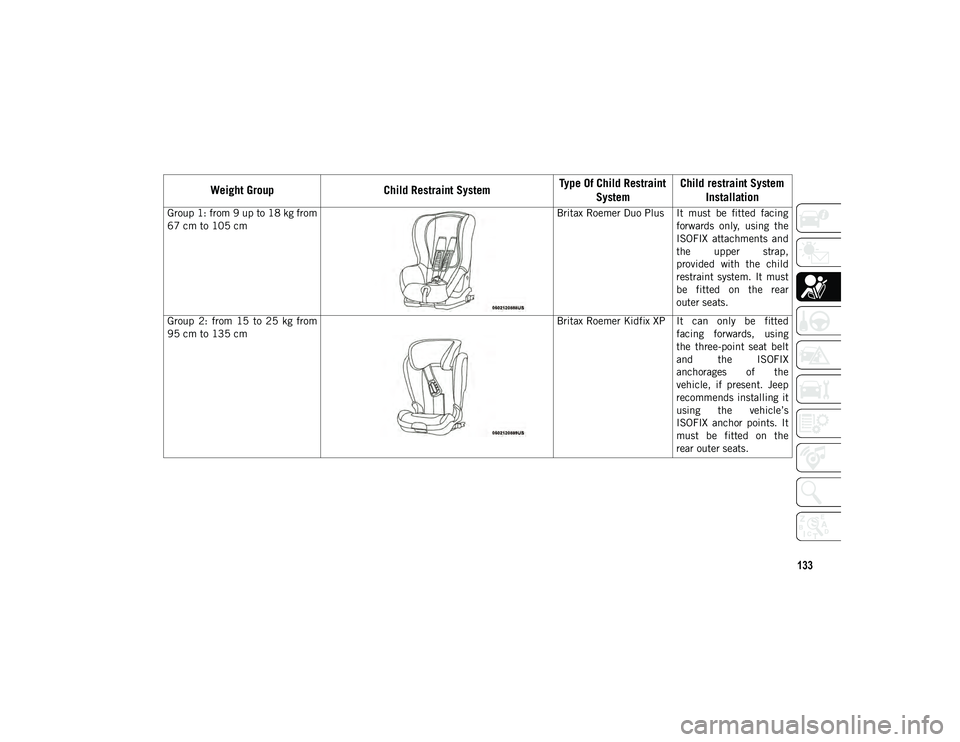
133
Group 1: from 9 up to 18 kg from
67 cm to 105 cmBritax Roemer Duo Plus It must be fitted facing
forwards only, using the
ISOFIX attachments and
the upper strap,
provided with the child
restraint system. It must
be fitted on the rear
outer seats.
Group 2: from 15 to 25 kg from
95 cm to 135 cm Britax Roemer Kidfix XP It can only be fitted
facing forwards, using
the three-point seat belt
and the ISOFIX
anchorages of the
vehicle, if present. Jeep
recommends installing it
using the vehicle’s
ISOFIX anchor points. It
must be fitted on the
rear outer seats.
Weight Group Child Restraint System Type Of Child Restraint
System Child restraint System
Installation
2020_JEEP_JL_WRANGLER_UG_RHD_UK.book Page 133